
Myth busting pork – 4 common misconceptions explained
For some people, pork doesn’t get much consideration past a roast or bacon which may be viewed as salty and fatty, while others might struggle to cook cuts like steak. However, fresh New Zealand pork is actually a powerhouse of goodness and cooked correctly is succulent and delicious.
Here we bust four of the most common myths surrounding pork, which will leave you salivating for your next New Zealand pork dinner.
Myth #1: All pork is fatty and unhealthy
When you think of pork, it’s quite common to immediately envisage a juicy pork belly or a roast with a thick layer of crackling. However, shift your focus and think chops, stir fries, skewers and steaks and you’ll understand that most cuts of pork are actually quite lean when the external fat (which is easy to remove) is cut off.
The leanest cuts of pork include the leg steak, fillet steak and schnitzel, (which have 3g, 3.5g and 4g of fat per 100g respectively). With summer just around the corner, it’s a great time to enjoy leg or filet steaks on the barbeque, and schnitzel is a family favourite any time of year.
After a spin on the Sunday Roast? We think you’ll love our Perfect Pork Steaks with Roast Veggies.
Myth #2: Pork does not contain key nutrients
A lot of Kiwis might not be aware of the many essential nutrients that are in New Zealand pork. Not only is it a great source of quality protein and zinc, it also provides iron and many B vitamins.
So, if you are hitting the gym (including the newly popular outdoor workouts!), New Zealand pork is a great protein option. You might also be interested to learn that a 100g pork fillet provides the same amount of protein as a 100g beef fillet (30g of protein)! Check out this yummy protein rich recipe to inspire your meal prep.
Iron is an important nutrient - being low in iron can result in feeling tired, lacking concentration, or having poor immunity. Pork is a good option to boost iron intakes as it contains haem iron that is easily absorbed in the body. Need some tasty iron? - we think you’ll love our Easy Pork Steak Tacos.
Similarly, it can be easier to absorb zinc from meats (as opposed to legumes, nuts, breads and cereals), and New Zealand pork is a good source of zinc – something we all need to assist with, healing wounds, supporting brain function, vision, and the immune system. All New Zealand pork provides zinc – and this Pork and Super Grain Salad Bowl hits the spot for a healthy lunch or dinner.
There are lots of different B Vitamins and together they look after your general health and keep your body functioning well. New Zealand pork boasts many of these B Vitamins, of which all tummies would benefit so we’ve put together this recipe with our littlies in mind!
Myth #3: Pork is salty
Sausages, bacon and ham, while very tasty, can often be quite salty. This is due to the processing they go through - i.e. salt is added as part of the processing or curing. In contrast to this, fresh cuts of pork are naturally low in sodium. You can even include fresh New Zealand pork as part of a low sodium diet! Click here to try out a new recipe for the barbie this summer.
Myth #4: Pork is dry and tasteless
Let’s face it, who hasn’t got a memory of their parents, or grandparents over cooking the pork chops and being left gnawing on a tough, dry piece of meat!?
But, it doesn’t need to be that way! Pork is a red meat and does not need to be cooked for as long as some might suspect. If you are cooking a lean cut of pork such as sirloin, leg/rump steak or a loin chop all you need is 10 minutes from start to finish – and that’s the 6+2+2 method!
1. Heat the pan to a medium / high temperature and season and oil your pork.
2. Fry the pork for 6 minutes on one side.
3. Flip the steak/chop over and fry for 2 minutes on the other side.
4. Rest the pork off the heat for at least 2 minutes
Now that you are in on the 6+2+2 secret, you never need to eat dry pork again!
Interested in finding out more about New Zealand pork and the nutrition benefits it provides? Click here to read more.
Source: All nutrient information is based on 100g of cooked meat and taken from the New Zealand Food Composition Database 2018.
For more news and blogs
Find your local butcher
Company
Products
Awards
Bacon, Ham, Pork
Woolworths Free Farmed Champagne Ham Shaved - Bronze winner 2025
Woolworths Free Farmed NZ Boneless Champagne Half Ham - Bronze winner 2025
Woolworths Free Farmed NZ Half Ham - Bronze winner 2025

Bacon

Cnr. Broadway Ave and Albert Street
Palmerston North
newworld.co.nz/lower-north-island/manawatu-and-wairarapa/melodys
Bacon, Ham, Pork
Manuka Honey & Jamaican Style Jerk Glaze Bacon - Silver winner 2025
Sweet Chilli Chipotle Bacon - Bronze winner 2025

Bacon, Ham, Pork
Meat Matas Leg Ham - Silver winner 2025
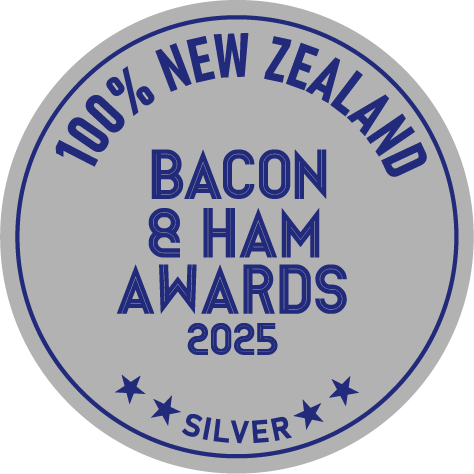
Bacon, Ham
Streaky Bacon - Bronze winner 2025

Bacon, Ham
Honey Cured and Manuka Smoked Ham - Bronze winner 2025

Bacon, Pork
NZ Pork Butt Bacon - Category Champion 2025
NZ Dry Cure Streaky Bacon - Gold winner 2025

Bacon, Ham, Pork
Rib Rocker Dry Cured Loin Bacon - Gold winner 2025
Dry Cured Loin Bacon - Bronze winner 2025

Shop 12
The Richmond Centre
Cnr Egmont & St Aubyn Streets
New Plymouth
Bacon, Ham, Pork

Bacon, Ham, Pork

Pork, Ham, Bacon

Bacon, Ham, Pork

Bacon, Ham, Pork
Expleo Dry Cured Streaky Bacon - Bronze winner 2025

Bacon, Ham, Pork

Available at selected supermarkets and stores across the North Island - check their Facebook page for the full list of stockists
facebook.com/p/Pirongia-Bacon-100057859741331/
Bacon
Pirongia Streaky Bacon - Silver winner 2025

Bacon, Pork
Gypsy Bacon - Gold winner 2025
Maple Middle Bacon - Silver winner 2025

4 Crofton Rd,
Ngaio
3 Geange St,
Upper Hutt
829 High Street,
Avalon
30 Dundas Street,
Seatoun
Bacon, Ham, Pork
Manuka Smoked Shoulder Bacon - Gold winner 2025
Honey Cured Ham - Gold winner 2025
Manuka Smoked Ham - Gold winner 2025
Honey Cured and Manuka Smoked Ham - Silver winner 2025

Bacon, Ham, Pork

Bacon, Ham, Pork

Bacon, Ham
Old School Pressed Ham - Category Champion/Supreme Ham Award 2025
Bushmans Streaky Bacon - Gold winner 2025
Old School Streaky Bacon - Gold winner 2025
Bushmans Bacon - Silver winner 2025
Old School Middle Bacon - Bronze winner 2025

Bacon, Ham, Pork
KFM American Streaky Bacon - Catergory Champion winner 2025
KFM American Dry Cure Streaky Bacon - Bronze winner 2025

70 Tiki Road,
Coromandel
Bacon, Ham

Bacon, Ham, Pork
Guanciale - Category Champion winner 2025
Green Middle Bacon - Gold winner 2025
Honey Cured, Manuka Smoked Shoulder Bacon - Gold winner 2025
Honey Cured, Manuka Smoked Middle Eye Bacon - Silver winner 2025
Dry Cured Streaky Bacon - Silver winner 2025
Italian Streaky Bacon - Silver winner 2025

Bacon, Ham, Pork

Bacon, Ham
Swiss Deli Dry Cured Smoked Bacon - Category Champion 2025
Swiss Deli Continental Spec Whole Bacon - Gold winner 2025
Swiss Deli Sliced Champagne Ham - Gold winner 2025
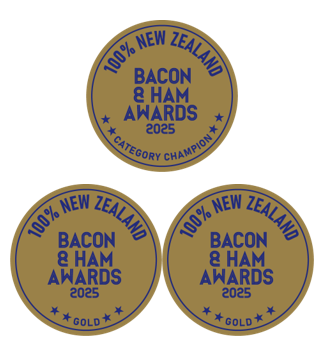
Bacon, Ham, Pork
Traditional Shoulder Bacon - Silver winner 2025
Dry Cured Streaky Bacon - Bronze winner 2025

Bacon, Ham, Pork
Mapari Free Range Streaky Bacon - Silver winner 2025
Mapari Free Range Ham - Silver winner 2025
Mapari Free Range Champagne Ham - Bronze winner 2025
Mapari Free Range Classic Bacon - Bronze winner 2025
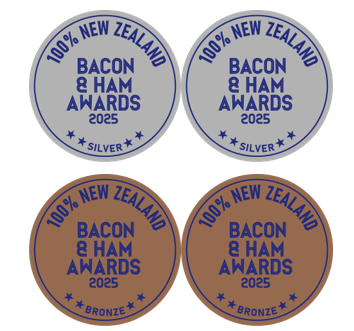
Bacon, Pork

Bacon, Ham, Pork
Dried Cured Middle Eye Bacon - Silver winner 2025
Dried Cured Shoulder Bacon - Bronze winner 2025

Bacon, Ham, Pork

Bacon, Ham

Bacon
Speck Bacon - Gold winner 2025
Deda's Picante Bacon - Silver winner 2025

Bacon, Ham, Pork
Dry Cured Middle Eye Bacon - Silver winner 2025
Nitrate Free Streaky Bacon - Silver winner 2025
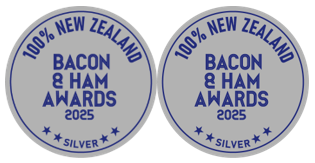
Bacon, Ham, Pork
Dry Cured Streaky Bacon - Gold winner 2025
Farmgate Heritage Ham - Bronze winner 2025

Bacon, Ham, Pork
Middle Bacon - Gold winner 2025
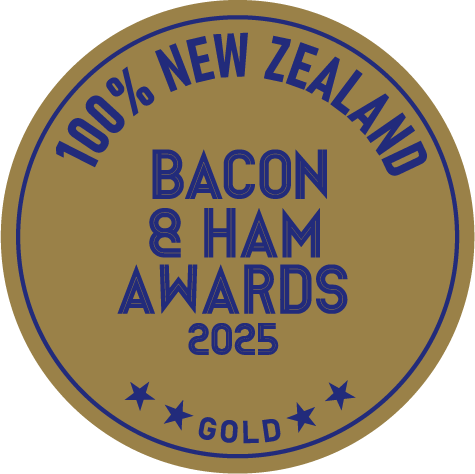
Bacon, Ham, Pork

Bacon, Ham, Pork
Honey Chilli Bacon - Gold winner 2025
Pork Pastrami - Silver winner 2025

Bacon, Pork
Free Farmed Loin Bacon - Gold winner 2025

4 Joll Road,
Havelock North
Bacon, Ham, Pork

26 Wanganui Flat Road,
Hari Hari,
West Coast
Bacon
Danish Back Bacon - Bronze winner 2025

Woolworths
Ham
Farmland NZ COB Ham Half - Gold winner 2025

Bacon, Ham
Champagne Ham - Category Champion 2025
Middle Bacon - Category Champion 2025
Middle Eye Bacon - Category Champion 2025

Bacon, Ham, Pork
2025 Winner - People's Choice Bacon
2025 Winner - People's Choice Ham

Bacon, Ham, Pork

237 Maunganui Road,
Mount Maunganui,
Tauranga
Bacon, Ham, Pork

Bacon, Ham, Pork

Bacon, Ham, Pork

Bacon, Ham, Pork
Authentic Dry Cured Middle Eye - Category Champion 2025
Dry Cured Streaky, BBQ Bourbon Bacon - Gold winner 2025
Dry Cured Streaky, with Egmont Honey - Silver winner 2025
Traditional Middle Eye Bacon - Silver winner 2025
Traditional Middle Bacon - Bronze winner 2025
Dry Cured Streaky, Candied Orange Glaze Bacon - Bronze winner 2025

Bacon, Ham, Pork
Reuben's Dry Cured Middle Eye Bacon - Gold winner 2025
Reuben's COB Ham - Gold winner 2025
Reuben's Boneless Loin Ham - Gold winner 2025
Reuben's Middle Free Range Bacon - Silver winner 2025
Reuben's Traditional Streaky Bacon - Silver winner 2025
Reuben's Boneless Ham - Bronze winner 2025

17 Queen Street
Wainuiomata
Bacon, Ham, Pork

Bone in Ham - Gold winner 2025

121 Codelia Street
Stratford
Bacon, Ham, Pork

23 Ocean View Road
Hillcrest
Bacon, Ham, Pork

Bacon, Ham, Pork
Naturally Maple Streaky Bacon - Category Champion/Supreme Bacon Award 2025
Bone in Ham - Gold winner 2025

239A Queen St
Auckland City
Pork

167 Puhinui Rd,
Papatoetoe
Auckland
Pork

61 Belmont Road
Paeroa
Bacon, Ham, Pork
Manuka Smoked Loin Bacon - Silver winner 2025
Manuka Smoked Streaky Bacon - Bronze winner 2025

Bacon, Ham, Pork

Bacon, Ham, Pork







